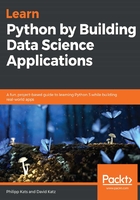
Notebooks
As we mentioned earlier, Jupyter is designed with a different approach to programming than VS Code. Its central concept is so-called notebooks: files that allow the mixing of actual code, text (including markdown and LaTeX equations), as well as plots, images, videos, and interactive visualizations. In notebooks, you execute code interactively, one cell after another. This way, you can experiment easily—write some code, run it, see the outcomes, and then tweak it again.
The outcomes are shown along with the code so that you can open and read the notebook, even without executing it. Because of that, notebooks are especially useful in scientific/analytical contexts, as on the one hand, they allow us to describe what we're doing with text and illustrations, and on the other hand, they keep the actual code tied to the narrative so that anyone can inspect and confirm that your analysis is valid. One great example of that is LIGO notebooks, which represent the actual code that was used to discover gravitational waves in the universe (this research won the Nobel Prize in 2017).
Notebooks are also great for teaching (as in the case of this book), as students can interact with each and every part of the code by themselves. However, while Jupyter is good for exploration, it feels less convenient when your code base starts to grow and mature. Because of this, we will switch back and forth between Jupyter and VS Code throughout the course of this book, picking the right tool for each particular job.
Let's now look at Jupyter's interface.